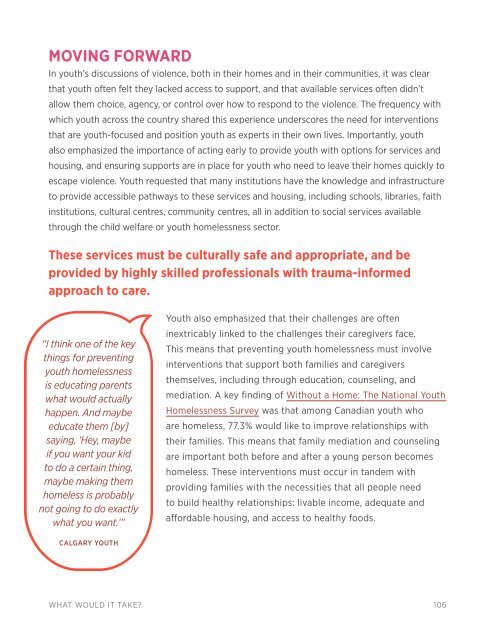COH-AWH-What_Would_it_Take
You also want an ePaper? Increase the reach of your titles
YUMPU automatically turns print PDFs into web optimized ePapers that Google loves.
MOVING FORWARD<br />
In youth’s discussions of violence, both in their homes and in their commun<strong>it</strong>ies, <strong>it</strong> was clear<br />
that youth often felt they lacked access to support, and that available services often didn’t<br />
allow them choice, agency, or control over how to respond to the violence. The frequency w<strong>it</strong>h<br />
which youth across the country shared this experience underscores the need for interventions<br />
that are youth-focused and pos<strong>it</strong>ion youth as experts in their own lives. Importantly, youth<br />
also emphasized the importance of acting early to provide youth w<strong>it</strong>h options for services and<br />
housing, and ensuring supports are in place for youth who need to leave their homes quickly to<br />
escape violence. Youth requested that many inst<strong>it</strong>utions have the knowledge and infrastructure<br />
to provide accessible pathways to these services and housing, including schools, libraries, fa<strong>it</strong>h<br />
inst<strong>it</strong>utions, cultural centres, commun<strong>it</strong>y centres, all in add<strong>it</strong>ion to social services available<br />
through the child welfare or youth homelessness sector.<br />
These services must be culturally safe and appropriate, and be<br />
provided by highly skilled professionals w<strong>it</strong>h trauma-informed<br />
approach to care.<br />
Youth also emphasized that their challenges are often<br />
“I think one of the key<br />
things for preventing<br />
youth homelessness<br />
is educating parents<br />
what would actually<br />
happen. And maybe<br />
educate them [by]<br />
saying, ‘Hey, maybe<br />
if you want your kid<br />
to do a certain thing,<br />
maybe making them<br />
homeless is probably<br />
not going to do exactly<br />
what you want.’”<br />
inextricably linked to the challenges their caregivers face.<br />
This means that preventing youth homelessness must involve<br />
interventions that support both families and caregivers<br />
themselves, including through education, counseling, and<br />
mediation. A key finding of W<strong>it</strong>hout a Home: The National Youth<br />
Homelessness Survey was that among Canadian youth who<br />
are homeless, 77.3% would like to improve relationships w<strong>it</strong>h<br />
their families. This means that family mediation and counseling<br />
are important both before and after a young person becomes<br />
homeless. These interventions must occur in tandem w<strong>it</strong>h<br />
providing families w<strong>it</strong>h the necess<strong>it</strong>ies that all people need<br />
to build healthy relationships: livable income, adequate and<br />
affordable housing, and access to healthy foods.<br />
CALGARY YOUTH<br />
WHAT WOULD IT TAKE? 106
















